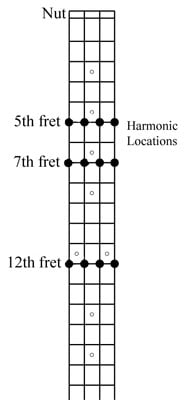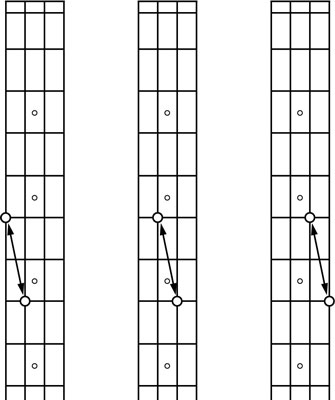One drawback of tuning a bass guitar to a fixed reference pitch is that the reference notes are in a higher octave. If you know how to use harmonics to tune a bass guitar, you'll find it easier to compare notes at an octave (or even two) apart. After all, if you tried to match the higher note, the string you’re tuning would snap and whip around your ears. Because the bass strings sound so low, the higher harmonics are much easier to hear.
When you lightly touch a string at certain points and then strike it with your right hand, the string naturally produces harmonics. The strongest and clearest harmonics can be found at the 12th fret, the 7th fret, and the 5th fret.

The sounds of the harmonics are crystal clear, which makes them a great tuning tool, but to use the harmonics, you must first develop a solid technique for playing them.
Lightly touch the desired string at the 12th, 7th, or 5th fret with one of the fingers on your left hand (the middle or index finger is best, but any will do).
Don’t press the string to the fret. Leave your left-hand finger at the contact point (12th, 7th, or 5th fret) when you strike the string with your right hand.
Place your right hand close to the bridge and strike the string with either the index or middle finger of your right hand.
The closer your striking (right hand) finger is to the bridge, the clearer your harmonic will be.
When the harmonic rings out, you can remove your left-hand finger from the string.
The harmonic will continue to ring out as long as you don’t touch the string.
When you strike a harmonic on a string that isn’t in perfect tune, you can hear a beating or wavering sound. This wavering sound takes a little getting used to. Just turn the tuning head until the wavering stops. When the tone is even, your string is in tune.
The following are the most important harmonics for tuning a bass guitar:
The 7th-fret harmonic on the G string (the thinnest string) is exactly the same note as the 5th-fret harmonic on the D string (the second-skinniest string).
The 7th-fret harmonic on the D string is exactly the same note as the 5th-fret harmonic on the A string (the second-thickest string).
The 7th-fret harmonic on the A string is exactly the same note as the 5th-fret harmonic on the E string (the thickest string).
 The relationships of bass guitar harmonics.
The relationships of bass guitar harmonics.
Harmonics aren't used strictly for tuning purposes. Being able to add harmonics to your bass line can create new and interesting colors in your music.

